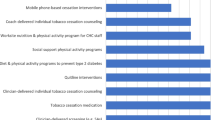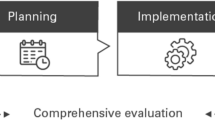Abstract
The South Carolina Cancer Prevention and Control Research Network (SC-CPCRN) implemented the Community Health Intervention Program (CHIP) mini-grants initiative to address cancer-related health disparities and reduce the cancer burden among high-risk populations across the state. The mini-grants project implemented evidence-based health interventions tailored to the specific needs of each community. This study aims to support the SC-CPCRN’s goals of moving toward greater dissemination and implementation of evidence-based programs in the community to improve public health, prevent disease, and reduce the cancer burden. Three community-based organizations were awarded $10,000 each to implement one of the National Cancer Institute’s evidence-based interventions. Each group had 12 months to complete their project. SC-CPCRN investigators and staff provided guidance, oversight, and technical assistance for each project. Grantees provided regular updates and reports to their SC-CPCRN liaisons to capture vital evaluation information. The intended CHIP mini-grant target population reach was projected to be up to 880 participants combined. Actual combined reach of the three projects reported upon completion totaled 1,072 individuals. The majority of CHIP participants were African–American females. Participants ranged in age from 19 to 81 years. Evaluation results showed an increase in physical activity, dietary improvements, and screening participation. The success of the initiative was the result of a strong community–university partnership built on trust. Active two-way communication and an honest open dialogue created an atmosphere for collaboration. Communities were highly motivated. All team members shared a common goal of reducing cancer-related health disparities and building greater public health capacity across the state.
Similar content being viewed by others
References
Friedman DB, Young VM, Freedman DA et al (2012) Reducing cancer disparities through innovative partnerships: a collaboration of the South Carolina Cancer Prevention and Control Research Network and Federally Qualified Health Centers. J Cancer Educ 27(1):59–61
US Cancer Statistics Working Group. United States Cancer Statistics: 1999–2008 Incidence and Mortality Web-based Report. Available from www.cdc.gov/cancer/npcr/uscs. Accessed 1 March 2013
Howlader N, Noone AM, Krapcho M et al (2011) SEER Cancer Statistics Review, 1975–2008. National Cancer Institute, Bethesda
Hebert JR, Elder K, Ureda JR (2006) Meeting the challenges of cancer prevention and control in South Carolina: focus on seven cancer sites, engaging partners. J South Carolina Med Assoc 102:177–182
Hebert JR, Daguise VG, Hurley DM et al (2009) Mapping cancer mortality-to-incidence ratios to illustrate racial and gender disparities in a high-risk population. Cancer 115(11):2539–2552
Suarez-Balcazar Y, Hellwig M, Kouba J et al (2006) The making of an interdisciplinary partnership: the case of the Chicago Food System Collaborative. Am J Community Psychol 38(1–2):113–123
Glasgow RE, Lichtenstein E, Marcus AC (2003) Why don't we see more translation of health promotion research to practice? Rethinking the efficacy to effectiveness transition. Am J Public Health 93:1261–1267
Glasgow RE, Vogt TM, Boles SM (1999) Evaluating the public health impact of health promotion interventions: the RE-AIM framework. Am J Public Health 89:1322–1327
Braun KL, Nguyen TT, Tanjasiri SP et al (2012) Operationalization of community-based participatory research principles: assessment of the National Cancer Institute's Community Network Programs. Am J Public Health 102(6):1195–1203
Main DS, Felzien MC, Magid DJ et al (2012) A community translational research pilot grants program to facilitate community–academic partnerships: lessons from Colorado's clinical translational science awards. Prog Community Health Partnersh 6(3):381–387
Zoellner J, Hill JL, Zynda K et al (2012) Environmental perceptions and objective walking trail audits inform a community-based participatory research walking intervention. Int J Behav Nutr Phys Act 9:6
Wiggs I, Brownson RC, Baker EA (2008) If you build it, they will come: lessons from developing walking trails in rural Missouri. Heal Promot Pract 9(4):387–394
Resnicow K, Wallace DC, Jackson A et al (2000) Dietary change through African American churches: baseline results and program description of the Eat for Life trial. J Cancer Educ 15(3):156–163
Erwin DO, Ivory J, Stayton C et al (2003) Replication and dissemination of a cancer education model for African American women. Cancer Control 10(5 Suppl):13–21
Resnicow K, Jackson A, Wang T et al (2001) A motivational interviewing intervention to increase fruit and vegetable intake through Black churches: results of the eat for life trial. Am J Public Health 91(10):1686–1693
Flegal KM, Carroll MD, Ogden CL et al (2010) Prevalence and trends in obesity among US adults, 1999–2008. J Am Med Assoc 303(3):235–241
Farag YMK, Gaballa MR (2011) Diabesity: an overview of a rising epidemic. Nephrol Dial Transplant 26(1):28–35
Nordestgaard BG, Palmer TM, Benn M et al (2012) The effect of elevated body mass index on ischemic heart disease risk: causal estimates from a Mendelian randomisation approach. PLoS Medicine 9(5):e1001212
Branca F, Lorenzetti S (2005) Health effects of phytoestrogens. Forum Nutr 57:100–111
South Carolina Community Assessment Network. Cancer Incidence and Cancer Mortality: 1996–2008. Available from http://infoweb02.dhec.sc.gov/scan/. Accessed 10 March 2013
Acknowledgments
This publication was supported by Cooperative Agreement Number U48/DP001936 from the Centers for Disease Control and Prevention and the National Cancer Institute (PI, J.R. Hébert; Co-PI, D.B. Friedman). This work was also partially supported by an Established Investigator Award in Cancer Prevention and Control from the Cancer Training Branch of the National Cancer Institute to J.R. Hebert (K05 CA136975). We would like to thank the communities that implemented and evaluated these intervention programs. The mini-grants program and associated documents were adapted from the Emory University’s Cancer Prevention and Control Research Network mini-grants program.
Author information
Authors and Affiliations
Corresponding author
Rights and permissions
About this article
Cite this article
McCracken, J.L., Friedman, D.B., Brandt, H.M. et al. Findings from the Community Health Intervention Program in South Carolina: Implications for Reducing Cancer-Related Health Disparities. J Canc Educ 28, 412–419 (2013). https://doi.org/10.1007/s13187-013-0479-8
Published:
Issue Date:
DOI: https://doi.org/10.1007/s13187-013-0479-8




